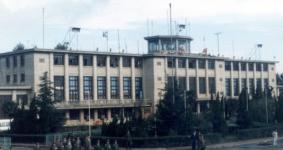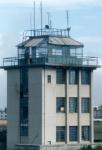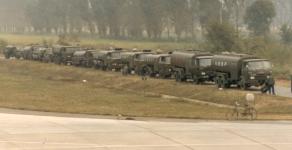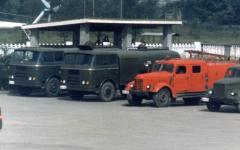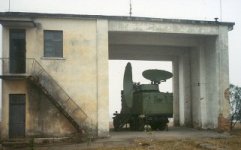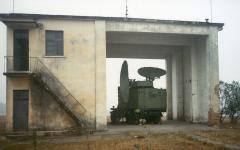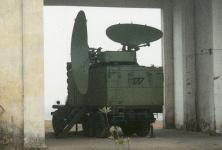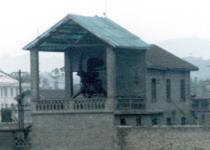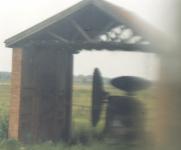





Rather than Taiwan facing 10 times its number of aircraft in a hypothetical attack by China -- solely based on a count of the total number of PRC and ROC aircraft in their entire inventories -- Taiwan will at worst face only 3 times its number of aircraft in a hypothetical attack by China -- based on a count of the number of revetments at airfields within range of Taiwan. Factoring in the far inferior quality of China�s aircraft versus Taiwan�s, China will be extremely unlikely with 3-1 odds to successfully achieve air superiority against Taiwan. The short to medium range PRC airfields (<= 600 km from Taiwan) -- those within striking distance of Taiwan -- experienced a slight increase (10%) in the number of revetments (from 342 to 373) during the thirty-year period from circa 1970 to 2000. These airfields could support a maximum of 1,119 combat aircraft, assuming each revetment could hold up to three combat aircraft.According to the Republic of China 1998 National Defense Report,
"At the 13 military-civilian airports within 250 NM away from Taiwan proper, the PRC's Air Force can station 1,200 combat aircraft.... At present, stationed on the air bases within 500 nautical miles from Taiwan are 1,300 aircraft, of which some 600 airplanes have a radius of operation over Taiwan proper."A review of historical and recently acquired high resolution satellite imagery essentially confirms this assessment.
The People's Liberation Army Air Force [PLAAF] order of battle, including the disposition of aircraft at particular airfields and the identity of specific units, cannot be established from readily available open sources. Generally, the PLA is organized into several Military Regions, consisting of Military Districts that correspond to Provinces. The largest PLAAF unit is the Division, which consists of three regiments, each normally with three squadrons of three flights, each with three or four aircraft. Thus, each air division would have between 75 to 100 aircraft [or as many as 125 aircraft, including maintenance spares].
The PLAAF currently has about 3,000 combat aircraft that might be used in operations against Taiwan, while the People's Liberation Army Navy operates nearly 600 aircraft. Both services have hundreds of other obsolescent aircraft of uncertain operational utility or availability. In practice, how much of this airpower could be brought into action against Taiwan is uncertain. This uncertainty is magnified, at least on an unclassified level, by the diversity of aircraft operated by the PLAAF and the difficulty of applying generic performance parameters to specific operational scenarios.
Aircraft Source Armament PLAAF
InventoryPLAN
InventoryCombat Radius [km] 2950 575 fighter attack J-11 FLANKER Su-27 AA-11 48 -0- 1500 ? 1000 J-8 FINBACK PL-2 / PL-7 / PL-9 150 136 800 ? 550 J-7 FISHBED MiG-21 PL-2 / PL-7 500 240 600-850 400-550 J-6 FARMER MiG-19 PL-1 / PL-2 1800 72 685 ? 450 JH-7 -0- 36 X 900 Q-5 FANTAN 450 92 X 400-600 PLAAF operations against Taiwan would require both air-to-air combat to gain air superiority, as well as air-to-ground attacks to support PLA naval, amphibious and other operations. Operating in an air superiority role, the J-6 FARMER and the J-7 FISHBED would have a combat radius in the range of 600 km to 800 km, while the more modern J-8 FINBACK has a combat radius of about 800 km. These figures do not include time on station, and patrol activities would significantly reduce effective combat radius [the nearly 1,400 km combat radius of the American F-16 is reduced to 370 km when allowance is made for two hours of operations on patrol]. Typically, dual role aircraft operating in the air-to-ground role have a combat radius about two-thirds that when they operate in an air-to-air role. When allowance is made for time on station, actual air-to-air combat radius is probably also no more than two-thirds of maximum combat radius. Although China flies several types of aircraft that are configured for dual-role operations by other countries, it is not apparent that these aircraft are configured for dual-role operations by China. Indeed, some reports assert that many Chinese fighter aircraft are not equipped for air-to-ground operations. It is apparent that pilots of fighter aircraft receive less training than those of attack aircraft, and consequently probably receive little if any training in air-to-ground operations. The Q-5 FANTAN attack aircraft, as well as fighter aircraft such as the J-6 FARMER and the J-7 FISHBED that might also conduct air-to-ground operations, typically have a combat radius of between 400 km and 600 km.
The availability of staging bases and a well developed infrastructure, especially airfields, were crucial to the Coalition's success in Operation Desert Storm. A decade later, the availability of airfield capacity was a limiting factor in the build-up of NATO airpower during Operation Allied Force:"There were not enough air bases in the area immediately around Kosovo to support all the aircraft committed to Operation Allied Force. Strike aircraft were placed on bases closest to Kosovo, and longer-range tankers were based at locales farther away ... Base infrastructure support for rapid deployment [was] not as extensive as support requirements needed for rapid employment and immediate sustainment.... " [ Kosovo / Operation Allied Force After Action Report, 31 January 2000]Civilian Airports
China's airport system was based on the political structure under Chairman Mao, whereby travelers were few and were on official business for the State. China's civil aviation industry has been hampered by the shortage and unbalanced distribution of airports. The Chinese policy of reform and opening to the outside world, starting in the late 1970's, created new opportunities for the development of civil aviation in China.
China's air traffic increased at rates near double that of the rest of the world for much of the late 1980's and early 1990's. China's airlines operated 425 jet aircraft with 70 seats or more at the end of 1997. China's airliner fleet currently represents some five percent of all the aircraft capacity in worldwide service, and this is predicted to double to 10 per cent by the year 2017.
Airports in China, historically under military or dual military/civil control are transferring management to all civilian control. Between 1990 and 1996 the Chinese air force had opened 71 military airports and more than 460 military air routes to civilian air services, and offered 53 reserve airports to civilian airplanes. Safety is becoming the most important determinant of these new management teams, where national security had been top priority with the military. Airlines in China have made great strides in improving safety after unhappily earning a place on the list of the most dangerous places to fly in the world in the early 1990's.
Over the past 20 years a large number of airports have been built and/or expanded in China. Airports will continue to be upgraded or built throughout China, requiring financial support, services and equipment from foreign sources. Ninety-five percent of the passenger transport of Chinese civil airports are handled by 41 major airports, including the airports in provincial capitals and capitals of autonomous regions and municipalities. Of these top airports, only eight were upgraded during the period from 1991 to 1995.
To catch up with the demand, China undertook a massive airport upgrade program as outlined in the Ninth Five Year Plan (9th FYP), building or upgrading the 41 airports accounting for 95% of China's passenger traffic. The targeted airports were the 27 provincial capitals, four central government-controlled municipalities of Beijing, Shanghai, Tianjin and Chongqing, and special economic zones and tourist destinations. By 2000, China planned to have built or renovated 70 airports. Much of the focus was on the big three airports in Beijing, Guangzhou and Shanghai which can handle up to 40 per cent of national traffic. Although the emphasis has been on major airport projects, China has also built or expanded regional airports. Chinese authorities planned to have 160 civilian airports by the year 2000, up from the total of about 110 in service in 1998.
As of late 1999, China had 122 civil operational airports, most of which were capable of taking off and landing Boeing 737's, and 19 of which are capable of supporting the taking off and landing Boeing 747 aircraft. Among all these airports, there are 31 airports certified by the International Civil Aviation Organization for international scheduled flights, international nonscheduled flights and international alternate services.
Military Airbases
It was reported in 1995 that there were normally some 177 PLAN/AF fighters stationed at the 13 bases within a 250-mile radius of Taiwan, including J-5 and J-6 fighters and Q-5 and H-5 bombers. At a radius of 250 to 500 miles of Taiwan, there were said to be more than 20 bases with nearly 1,300 combat aircraft [FBIS-CHI-95-141, 24 July 1995]. Under the operational concept of "few troops at the front and more troops in mobility" it was reported that the PLA can "fill to the full" the frontline airfields with principal fighters in a few days. As of early 1998, some 1,300 aircraft were stationed at the air bases within 500 nautical miles from Taiwan, of which some 600 airplanes had a radius of operation over Taiwan proper.Taiwan lies off the coast of China, roughly equidistant between Shanghai to the north and Guangzhou [Canton] to the south. The PLAAF has nearly two dozen airfields and airbases within a 600 kilometer radius of Taiwan, a perimeter that roughly defines the typical combat radius of Chinese aircraft, and over two dozen other airfields within an 800 kilometer radius of Taiwan that could also support combat operations.
- Eight coastal airfields -- six in Fujian Military District directly across the strait, as well as one airfield in Guangdong Military District and another in Zhejiang Military District, lie within a 400 km radius of Taiwan's airspace. These airfields are well situated to support dual-role aircraft performing air-to-ground missions, though doctrinally they are likely to support air defense operations. However, two of these airfields are civilian airports that lack support infrastructure for military operations.
- Thirteen more airfields lie at somewhat greater distance, but within a 600 km radius of Taiwan's airspace. These bases include two inland airfields in Fujian Military District, three airfields in Guangdong Military District, one in Anhui Military District, and seven in Zhejiang Military District. These airfields would support the full range of PLAAF air assets performing air defense and air-to-air combat missions. In addition, they could support air-to-ground operations by the Q-5 FANTAN and some longer-range variants of the J-7 FISHBED.
- Over two dozen other airfields are located between 600 km and 800 km from Taiwan's airspace, including the extensive facilities surrounding Shanghai and Guangzhou. These airfields [at least 30 in total] could support air-to-air and air defense missions flown by the J-8 FINBACK and some longer-range variants of the J-7 FISHBED. However, even these aircraft would be operating at the outer reaches of their effective combat radius, with little reserve fuel for loitering in the combat zone.
Chinese flight operations would be further constrained by requirements not merely to reach Taiwan, but also to operate in Tawainese airspace -- Taiwan's landmass has an average width over 100 km when approached from the mainland. Aircraft flying air-to-ground missions against Taiwan proper would probably stage from the six coastal airbases located in Fujian Military District as well as the single airfields in Guangdong and Zhejiang Military Districts that lie within a 400 km radius of Taiwan. The other thirteen airfields in neighboring Anhui, Zhejiang, Jiangxi and Guangdong Military Districts that are within 600 km of Taiwan would primarily support air superiority operations. There are perhaps another dozen [but fewer than thirty] other airfields located at greater distances that could contribute to air superiority operations against Taiwan. However, aircraft flying from these more distant fields would operate with less effectiveness relative to more forward based aircraft.
A few other out of area airfields are also of interest. The three reported bases for the Su-27 are all well removed from the immediate area of Taiwan, though not outside the range of these high performance aircraft. The basing for the Q-5 attack aircraft is unknown.
China has constructed 14 major air bases on the Tibetan Plateau, and a score of tactical airstrips. These bases give the Chinese air force control of Tibet's air space, the forward edge of battle in the event of war with India, and the capability to fly sustained combat operations over India's north and strike all India's northern cities, including Delhi, Bombay and Calcutta. Chinese electronic intelligence atop the plateau also confers an important advantage of combat information and battle management in any, air war. The high altitude of the airfields in Tibet is frequently suggested as precluding effective PLAAF air operations against India. The PLAAF may be able to overcome this problem through aerial refuelling, with strike aircraft taking off from lower-altitude airfields further away, and refuelling over Tibet for strikes at airfields or other targets in northern India.
Infrastructure capabilities and limitations can significantly affect air combat operations. A detailed analysis of airfield suitability would require more current and detailed data than can be obtained on an unclassified basis, but some important points are evident. At the time of the Gulf War, Iraqi aircraft were deployed at more than 24 primary and 30 dispersal airfields throughout the country. The main operating bases were well constructed, built to withstand conventional attack. The Iraqis could shelter almost all their aircraft in hardened shelters, some built by Yugoslav contractors to standards believed to be able to withstand the effects of air burst detonations of tactical nuclear weapons. These sophisticated survivability measures are absent from Chinese airfields.Many of the military airbases have revetted parking areas, typically a few dozen in number. Generally, the parking areas of these large revettments are about two dozen meters across, and each is capable of accomodating two or three aircraft. Thus, a typical airbase can sustain two or three Air Regiments, and between 50 and 100 aircraft.
PLA Air Force combat units require logistics support (to include maintainers, POL and munitions handlers) for sustained operations. Airfields would need to be expanded to improve combat operations capability. Weather conditions could slow combat operations at visual flight rules (VFR)-only airfields. Some of the airfields would have to make instrument flight rules (IFR) capable of allowing unhampered 24 hour operations. It is generally admitted that the practical capacity of a single runway is 40 IFR movements per hour (take off and landing). Fuel and weapons storage sites would need to be built from scratch, or dramatically expanded. Sortie generation would also need to be improved by deployment of materiel handling equipment and by expanding ramp space and ramp facilities. Additionally, since there is a threat of airbase attack from air or special operations forces, a base defense network would need to be established, and hardened aircraft bunkers (HAB) would need to be constructed. Hardening increases structural strength and ballistic protection. Revetments, earth berms, and similar structures are effective means of ballistic protection. Expedient methods such as sandbags, salvaged culverts, or steel drums filled with earth are effective methods to reduce casualties and damage. Some runway surfaces might need to be reinforced to prevent break up of the runway surface by heavy transport aircraft. Revetments
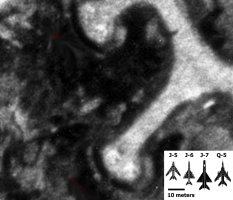
When the US Air Force arrived in Saudi Arabia to support Operation Desert Shield/Desert Storm, some Saudi bases were modern facilities, while others were little more than a runway, a parking ramp, and sand. Facilities for more aircraft were needed closer to the Kuwaiti border, so a new base was constructed at Al Kharj, about 60 miles south of Riyadh. The base was a massive Saudi military installation, but only a runway, a taxiway, and a parking apron had been constructed. Al Kharj was ready for aircraft early in January 1991, supporting 4,900 Air Force personnel.
By the time of the 1991 Gulf War, most of Iraq's combat aircraft were in widely dispersed hardened aircraft bunkers (HAB) with thick concrete walls. Many of Iraq's airfields had two or more widely separated long runways, connected by redundant taxiways which could be used as a runway for emergency operations. Multiple-approach taxiways connected each aircraft bunker to the runway, providing redundant means to gain access to operating surfaces.In contrast, Chinese airbases lack hardened aircraft shelters, and revetments are frequently connected to runway areas by a single taxi-way.
